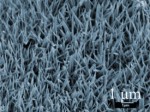Chinese scientists have developed a highly efficient and chemically stable hydrazine sensor using carbon modified zinc oxide nanorods. Hydrazine is highly neurotoxic and carcinogenic and can cause severe damage to the liver, lungs and kidneys. It is used extensively in industry, and for safety considerations a reliable hydrazine sensor is highly desirable.
To find out why this new sensor is special, read Jacob Bush’s news article at Highlights in Chemical Science or access the full article via Dalton Transactions:
C@ZnO nanorod array-based hydrazine electrochemical sensor with improved sensitivity and stability
Jinping Liu, Yuanyuan Li, Jian Jiang and Xintang Huang
Dalton Trans., 2010, Advance Article
DOI: 10.1039/C0DT00258E











